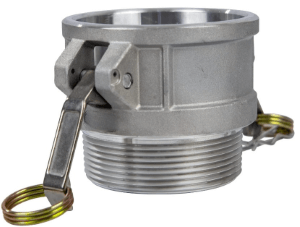Camlock fittings play a pivotal role in fluid handling across diverse industries. Understanding their types and applications is crucial for efficient operations.
What is Camlock Fitting?
Camlock fittings are mechanical devices. They are designed for quick and secure connections in fluid transfer systems. These fittings are famous for being simple and reliable. They have male and female ends that interlock easily. The mechanism is a simple snap and lock.
Key Components
Male and Female Ends
Camlock fittings feature male and female ends. The male end is also called an adapter. It has external threads. The female end is also known as a coupler. It has internal threads. The threads create a tight seal when connected.
Handles and Levers
Handles and levers are important parts of camlock fittings. They make it easy to connect and disconnect the male and female ends. They provide the necessary leverage for a swift and secure connection.
Common Materials Used
Stainless Steel
Stainless steel camlock fittings are prized for their corrosion resistance and durability. They are ideal for applications that require durability and long-lasting performance. These valves are widely used in chemical and industrial environments.
Aluminum
Lightweight and corrosion-resistant, aluminum camlock fittings are suitable for various applications. They are easy to handle because they are malleable. That’s why industries like firefighting find them popular.
Brass
Brass camlock fittings strike a balance between strength and malleability. Brass fittings are often used in water-related applications. They provide reliable performance and are resistant to corrosion.
Polypropylene
Polypropylene camlock fittings excel in chemical resistance. They are lightweight and cost-effective. Industries that deal with acids, alkalis, and other corrosive substances prefer them.
Types of Camlock Connections
Male Adapter to Female Thread
To create this type of connection, you join the male adapter with external threads. The male adapter is connected to a female coupler with matching internal threads. It ensures a secure and leak-proof link.
Female Coupler to Male Thread
The female coupler has internal threads. It connects to the male adapter with external threads. It provides a reliable and quick connection for fluid transfer.
Female Coupler to Hose Barb
Camlock fittings are commonly used for flexible hose connections. They have a female coupler that attaches to a hose barb. This setup ensures a secure and adaptable link.
Female Coupler to Female Thread
A female coupler with internal threads can connect to another female thread. This creates a versatile connection. This connection is threaded. This connection provides flexibility in system design.
Male Adapter to Hose Barb
This type involves connecting the male adapter with external threads to a hose barb. It allows for a secure connection between the camlock fitting and a flexible hose.
Male Coupler to Male Thread
Join two male threads by connecting a male coupler with external threads. This creates a threaded connection for specific applications.
Comparisons with Other Fitting Types
Camlock vs. Threaded Fittings
A comparative analysis examines camlock fittings and threaded fittings. It explores the pros and cons of each type. The analysis sheds light on situations where one may be better than the other.
Camlock vs. Quick Disconnect Couplings
Both camlock and quick disconnect couplings are efficient ways to connect and disconnect hoses, pipes, or other equipment quickly and easily. However, they differ in design, operation, and suitability for different applications. Let’s delve into their key characteristics to help you choose the right option for your needs.
Key Differences:
| Feature | Camlock Fittings | Threaded Fittings |
| Connection | Lever-operated latches | Screw threads |
| Sealing | Rubber gasket | Thread tape or sealant |
| Connection speed | Quick and easy | Slower, requires tools |
| Durability | Very durable | Durable, but threads can wear |
| Cost | More expensive | Less expensive |
Camlock Fittings
Connection: Two levers lock or unlock a cam arm, securing the male and female ends together. No tools are required.
Sealing: A rubber gasket creates a leak-proof seal, eliminating the need for tape or sealant.
Flow Rate: The smooth inner bore with fewer internal components minimizes flow resistance, resulting in high flow rates.
Durability: Typically made from robust materials like stainless steel, ensuring longevity and reliability.
Applications: Widely used in industries like agriculture, construction, food and beverage, chemical processing, and firefighting.
Quick Disconnect Couplings
Connection: Various mechanisms, including push-pull levers, twist collars, or single-handed buttons, engage or disengage the male and female ends.
Sealing: Seals vary depending on the type of quick disconnect, but some may require additional sealing tape or sealant for tighter connections.
Flow Rate: Internal components can sometimes restrict flow compared to camlocks, particularly for thicker fluids or slurries.
Durability: Material options range from plastics to metals, impacting overall durability.
Applications: Ideal for frequent connections and disconnections in tasks like irrigation, air tools, fluid transfer, and medical equipment.
Also, read ⬇️⬇️⬇️
Fluid Flexibility: T Port Vs L Port Showdown
Unlocking The Intricacies Of Hydraulic Tees
Demystifying 3/8 Hydraulic Fittings: Understanding Sizing And Functionality
Conclusion
It is crucial to understand the different types of camlock fittings. This will help you select the correct components for fluid handling systems. The selection of materials depends on the specific requirements. The selection of connection types depends on the specific requirements of the application.
Understanding the key components and configurations ensures seamless fluid transfer. Stainless steel is used for chemical resistance, while polypropylene handles corrosive substances. Efficiency is achieved by knowing the right materials for fluid transfer.
Post time: Jan-12-2024


